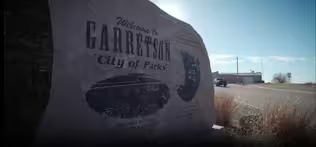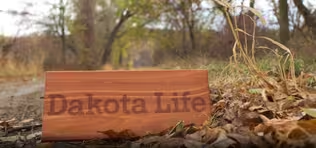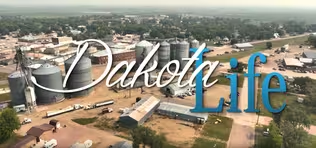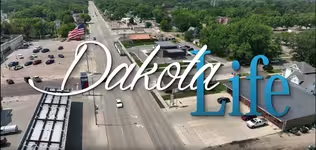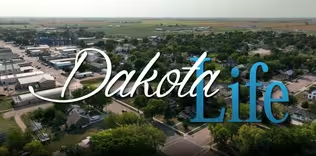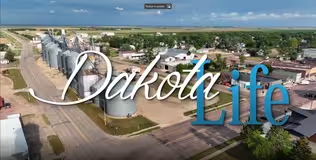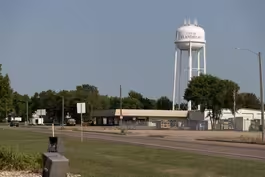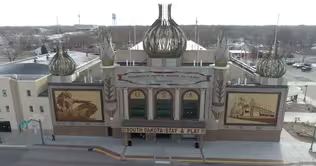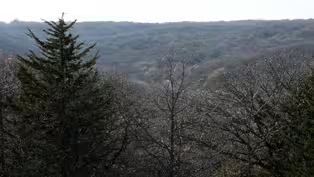Dakota Life
Greetings from Beresford
Season 26 Episode 8 | 26m 26sVideo has Closed Captions
Beresford hosts the Frostbite 4, a regional favorite winter road race.
Join us to learn about a Beresford record collector, a local road race, a car collector, and young business owners revitalizing Main Street.
Problems playing video? | Closed Captioning Feedback
Problems playing video? | Closed Captioning Feedback
Dakota Life is a local public television program presented by SDPB
Support Dakota Life with a gift to the Friends of Public Broadcasting
Dakota Life
Greetings from Beresford
Season 26 Episode 8 | 26m 26sVideo has Closed Captions
Join us to learn about a Beresford record collector, a local road race, a car collector, and young business owners revitalizing Main Street.
Problems playing video? | Closed Captioning Feedback
How to Watch Dakota Life
Dakota Life is available to stream on pbs.org and the free PBS App, available on iPhone, Apple TV, Android TV, Android smartphones, Amazon Fire TV, Amazon Fire Tablet, Roku, Samsung Smart TV, and Vizio.
Providing Support for PBS.org
Learn Moreabout PBS online sponsorshipMore from This Collection
Dakota Life stories from towns in southeast South Dakota
Greetings from Wessington Springs
Video has Closed Captions
Most cities shape the landscape they’re on, but in Wessington Springs it’s the other way around. (29m 45s)
Video has Closed Captions
Discover the beauty and history of Palisades State Park, goat yoga, and a very special love story. (29m 46s)
Video has Closed Captions
From a window to the past to raising the next generation, Dakota Life explores Wagner. (28m 53s)
Video has Closed Captions
Greetings from Madison, the center of Lake County. (28m 55s)
Greetings from the Corn Palace
Video has Closed Captions
Greetings from the Corn Palace plus stories from southeast South Dakota and Aberdeen. (26m 16s)
Video has Closed Captions
Dakota Life showcases Newton Hills and the SD State Park system. (28m 5s)
Providing Support for PBS.org
Learn Moreabout PBS online sponsorship- This is a production of SDPD.
- The family of Eli Ricard was the first to settle on a homestead in Prairie Township in what is now Union County.
A small town sprang up and Ricard called it Paris.
He named it after his French heritage.
Well, Mr. Ricard operated a Paris Post office from the frame house he built on his homestead.
But that all changed when a city was officially plotted out in 1873.
You see German steel for the railroads and English money to pay the bills was behind much of the development that took place in northwest Iowa and southeastern Dakota territory.
And the town Ricard called Paris.
Well, that changed too.
It changed to Beford.
It was named in honor of Lord Charles Beford, an admiral in the British Royal Navy.
His English money invested in railroads came with a little perk to have a town named after him.
Beford was formally incorporated July 12th, 1884.
As far as Admiral Lord Charles Beford, well, he never paid a visit.
Today, Beford is a charming small town that straddles the border between Northern Union and southern Lincoln counties.
Beford has always been kind of a crossroads.
It's a peaceful, picturesque place that boasts a rich history that's evident in the historic buildings and landmarks.
So let's have a look around.
Welcome to Dakota Life.
And greetings from Beer Spring.
- This episode of Dakota Life is supported by our members.
Thank you.
With corporate support from First Dakota National Bank.
First Dakota has supported the dreams of families, businesses, and communities for over 150 years with personal business and ag banking solutions for every stage of the journey.
And by Fiesta Foods in Beford, family owned and operated, and proud to serve the Beford area with freshness and variety, with everyday essentials and special orders, and a full service deli with home cooked meals.
Fiesta Foods, local goodness - From French fur traders and Lewis and Clark.
It seems people have continually been traveling through this area.
Some of them stop and put down roots, but the rest just keep moving on.
In the spring of 1883, the growth of farming inspired some to establish businesses here in Bear Street.
One of the first structures was a saloon built and operated by DC Ette.
It was destroyed by fire.
Later, the JW Rey residence was believed to be the first home built in Bersford pioneers and businesses kept on coming.
As the century turned, the main thoroughfare from north to south was US Highway 77.
And at its height, you could have traveled from northeast, South Dakota, grew Beford all the way to the Gulf of Mexico.
But in South Dakota, 77 was decommissioned.
In the 1960s, you see the brand new Interstate 29 ran parallel, and in some cases less than a mile away.
But not to worry, the old 77 roadway is still there.
In fact, a local economist at the time said that I 29 was the best thing that could have ever happened to Beers Street.
You could easily get somewhere and get back home.
But while we're here, we're gonna visit a Beford man who amassed a world-class vinyl record collection.
We're gonna see how the heritage of that old Highway 77 still echoes through a collection of restored vehicles.
But first, now all of you who enjoy jogging along the roads or trails during the summer, you can actually start your season early in early February.
As a matter of fact, it's Beers, Ford's annual Frostbite four road race.
- Every February people flock to Bersford for a one of a kind winter extravaganza that's called the Frost by four.
This unique event brings out the locals and those from around the area to compete in either a four or two mile run with one common goal to have some fun.
- We are just getting some fresh air and exercise.
Yeah, we were.
- This is, this is this tradition and this is the tradition.
First time for both of us to do the two mile walk I normally run.
- Yeah.
First for me, you know, it's much nicer than I was thinking it would be.
So it's good.
It's refreshing.
- And while a lot of the participants are from Beford, there's quite a few who are not.
- I actually ran, my first race ever was the, was the first crossbite for, so I have been running for almost 26 years.
I haven't done every race here, but I wanted to be here for the 25th.
My looks are cold.
- This year's event was bigger as it was the 25th year anniversary.
The race started with participants boarding buses and getting driven to the starting line.
The race then brought people back into town towards the finish line at the high school.
- It's always been a good turnout.
It's always brings in a lot of people, and it's just so much fun.
I see people that I know here sometimes just once a year and we meet up here.
So it's, it's just always so fun.
Weather.
- The weather was good.
It was good.
Oh yeah, - It felt great.
- There's also a kids' race as well.
- It was cool.
- It was kind of cold.
You cold still?
Yeah, - Afterwards, there's a soup dinner with awards, but it's the bond that people create and the good cause of raising money for the beers, for Booster Club that keep people coming back.
- We've been running the crossbite ever since.
I have been running the Crossbite ever since it started every year.
And my son, Kayden, is also running it with me.
He's been running it.
What then?
Five years, probably more people and I don't know, I guess it's getting harder for me, but - It's more than just a race.
It's an event, an event that involves numerous people of South Dakota coming to Bersford in the middle of winter.
It's the fun of it that keeps bringing back people year after year - For us.
It's an hour.
- I'm from Mount Vernon, South Dakota, so it's about two and a half hour drive.
So it, it's a great, it's a great run.
It's awesome.
I love it.
So - The Frostbite four gives a real economic boost to the Bersford athletic boosters.
The community also used to enjoy another boost, and this from an entertainment landmark created in 1926.
It's a couple of miles south of Bersford.
Mike Mullen court realized there was a spot along Highway 77 that was centrally located to many small surrounding communities.
And it was ideally situated for a ballroom.
The Ritz Ballroom boasted a 6,000 square foot dance floor.
The Ritz had a capacity of about 800, but on special occasions, you might find as many as 5,000 people attending dancers.
Well, they came from all around the area to hear big bands.
Lawrence Wal played the Ritz many times, but the biggest draw ever came in 1931.
That's when the internationally known brick tops played at the Ritz.
The brick tops were a 14 girl band made up entirely of redheads from New York.
And on that night, all redheaded dancers were admitted.
Fray.
Well, since we're talking about music history of sorts, let's have a visit with a Bersford man who helped keep music history alive - In a little cabaret in a south Texas border.
Towns had a boy and his guitar, and people came from miles around and all their girls from here to Vermillion Horse slipping away.
- For Ed Westberg music has always been a part of his life.
- Well, my mother was a musician and she insisted that my sisters and I started taking piano lessons when we were in the first grade.
I wasn't too excited about it, but I did.
The music teacher, she retired after four years, so I didn't play the piano anymore.
I just know how to play some chords.
But I got interested in music and just sat in the basement of the house over here and learned how to play the guitar by myself.
And - Chances are you've seen that on stage with his old band performing at Wedding dances or just strumming his old guitar at the local nursing home.
- That's that I did that.
Didn't do the last verse.
I had enough trouble with the first two.
- But his appreciation for the art farm goes much deeper than just playing.
- So I built this and if I'd have known I was gonna have as much music as I have, I probably would've built it bigger.
'cause I have a lot of music.
It isn't in here, down the old building called an Old Hog House that got, I got about 9,000 just 78 records and got over 60,000 all together.
So I got a lot of eight track tapes and I heard cassette tapes and I just kept on collecting.
Plus, I got some of these little records here made in around 1905 and 19 six.
I didn't even know they made records like that, especially back in those days.
I got a lot of them.
So like I say, when you get to collecting, you find out a lot of things.
- This vast collection is centered around many things.
But one of them being the king of Rock and roll himself - Heard Elvis Presley once.
And I thought that was cool.
So I just started liking music, got a lot of tapes, even playing cards of Elvis down.
There's a bunch of eight tracks of Elvis, and this was a promotional song, not to men record, but not to be sold.
So that's worth a little bit more.
I have 145 different albums.
Albums.
Like I said earlier, he made several of 'em after he died.
I don't know how he did that, but he did.
But Memphis Paper, when Elvis passed away, - What was that day like when Elvis passed away?
- Well, to me it was a sad day.
I don't know what it was to anybody else, but I was doing something around here and had the radio on it and I heard it and I just, I felt so bad when it happened.
But it was only, what, 42, 43 years old.
And it passed on.
It's too bad.
- Music may be the centerpiece, but Ed's got many sports items, including a sports piece that stars South Dakota's most famous newsman.
- I was a freshman in high school, and Bersford played Yankton in the State Aid regional Tournament.
We were a Class A 'cause there was only two classes there.
And we were one of the 32 digger ones at that time.
And he had his book out and he wrote in there when he was in high school, he was so looking forward to playing in a tournament.
And in some small town, he said, beat him and upset him.
And a guy by the name of Joe Thorn who played Gordon, was so tough on him.
And so I went to that tournament and being like my rest of my family, I didn't throw anything away.
So I still had the program.
But when we played Yankton that year, and he had a book signing deal at Barnes and Noble in Sioux Falls.
So I took my program up there and when I got in line and when I got to meet, I just pushed that program in front of him and he looked up at me and he said, that was a terrible game.
And I said, no, March 7th is my birthday as I pointed.
So he autographed it.
And so I got the program and Tom Broco was playing basketball in high school.
So - Ed's passion for music, whether he is playing or collecting - A Watergate, Washington DC, he got a match book from Watergate - Shows his passion for life.
- Just, it means to me that people have different hobbies.
I just love, I just love it.
I just, when I look at all those things, 'cause I was a young person and I, I've seen the Everly Brothers and they were still alive, and I got their sheet music and Rick Nelson's and all kinds of different people.
I just, just makes me happy when I will mountain, see it.
So that's it.
- One of the things I find unique about a town the size of Beer Street is the large amount of public green space.
It goes right through the middle of town.
Now, forward thinking planners established Bulo Park and its anchor, the Rock Wall Outdoor Amphitheater.
Now, the park has continued to evolve over the past 60 years as a modern swimming pool and waterpark.
There's outdoor recreation areas like a playground disc, golf pickleball, and basketball courts.
And there are several baseball and softball fields on the north end of town.
Plus there's a challenging, updated nine hole golf course.
Since homesteading times education has been high on the priority list for Bersford, the library has been ranked between four and five stars by Library Journal Magazine, one of the few libraries in South Dakota to achieve that status.
The ranking is determined by usage, budgets and other criteria established in 1923.
The Bersford Public Library provides a summer reading program with special events on Tuesday and Thursday nights in June and July.
Now, Glennon Knutson farmed near Centerville.
His love to restore old cars to the way they looked originally was sparked high school.
And that love has continued for 60 years.
He's kept most of them.
So when he and Mary moved to Bersford, they needed a place to show 'em off.
- Well, you know, when we sold our acreage, we lived on the farm.
He lived on the farm for 70 years.
We actually had a lot of these cars in a machine shed, but it was kind of a machine shed slash museum - Warehouse, - Warehouse.
Then when we moved to Bersford, he said, oh wow, you know, I have to have a place for my cars.
You know, thus came this museum, - In the museum here.
This is free.
We don't charge, we don't want to charge people for coming because I enjoy this museum of just being able to see what I have.
Whereas I couldn't do that on the farm.
I, I can look around and, you know, it's kind of nice and this is nice.
I enjoy that.
Plus, I enjoy visiting with the people that come.
- It's the old Highway 77 Museum.
It's on the southwest corner of Beford.
In fact, a corner of the old roadway would've gone right through where the building stands now.
But first, let's go back to the beginning.
- My dad taught me at a young age, mechanics, we were building things with torches and welders.
And when I was in high school, my brother was dating a girl from Irene that her, her dad lived out by the Jim River.
And so he had a lot of antiques and he had two model T Fords.
One was a 27 and one was a 1925.
And he decided that he was going to give one to my brother.
And, but then he didn't wanna leave me out, so he gave each of us a bottle tea.
- So I knew right from the beginning, you know, what I was getting into.
And it's been good ever since.
You know, it's been a fun hobby for both of us.
- All of the cars here are road ready and they've toured them all over the country.
And in Australia, Mary and her daughter Jill, have decorated the museum from mannequins to signage while Glendon restores vehicles back to their showroom days.
- Fords and Chevy's, which are two of the more common cars, they're people that reproduce a lot of parts for those cars.
Okay?
So they actually make it a lot easier to, to restore.
But when you get into a, to a dodge pickup, like behind you here, there isn't anything made for that truck.
And, and it was rusted out terrible.
I spent hours and hours manufacturing fenders.
I have to manufacture the tool to make the part.
Sometimes that takes longer than manufacturing the part.
- And with all the cars he's restored, Glennon can tell you - That is true.
They don't make 'em like they used to.
This car that's right next to us here weighs almost 5,000 pounds.
And, and a lot of it's on it's unnecessary pound each.
It's just the fact that they were, I don't know if they were trying to build a tank or what they were trying to build, but it's, it's extremely heavy.
So comfort wise, I can say, yes, they probably, this car probably floats over the road better than our cars today.
They built them quiet.
But to drive this car, there's no power steering.
There's no power brakes.
So it drives like a truck.
- But the joy of these cars is not about the destination.
It's been about the journey for Merriam Glendon.
And it will continue until, oh, - If Glennon goes first, the funeral's at 10 in the morning.
The auction's at two in the afternoon.
- Old Highway 77 used to make a gentle curve over the land where the museum is located now.
In fact, if the roadway were still there, it would go right through the middle of the building.
Lawrence Tiny Lorenson was remembered for his promotion of baseball.
In July, 1984.
A ceremony dedicated the big baseball field to the name of tiny Lawrence Renson.
Tiny managed umpire and donated time and effort in helping renovate the field.
And now when the lights are shining on a summer night, it means there's a home game in Beford.
Many towns this size have a few things in common.
Community caring and a desire to rebuild the downtown area.
Hereford is no different.
We're gonna meet some young business owners, creating a community.
- There wasn't a lot of really anything to do down here.
I can't remember pretty much everything that was open wasn't even downtown.
So we always had to go to the other side of town, which you know, isn't far.
But there wasn't really anything fun to do, you know, downtown, anywhere to go hang out.
- I can remember there was a, a little shoe store, and then there's a fabric store in town.
There have always been the banks and the gas stations and the lawyer's offices.
- There a lot for like younger people.
Really.
Not somewhere you could just hang out or stay or meet a friend or anything.
- The vitality of Main Street in many rural communities have ebbed and floated over the years.
Third Street in Beford is no different.
There are memories of movie theaters, three grocery stores, and even clothing stores.
- You realize how important your businesses are in town and how much you know, how wonderful it is to have a grocery store in town.
- It's when the community came together to make improvements that sparked a new sense of purpose.
- So in about 1997, there was a kind of a coffee group that met, and one of the coffee members said, you know, there is not any type of entity in Bersford where people can give money to go back to the community or the school.
- That's how the Bersford Area Community Foundation began.
They started by funding a need, - Starting out with $150,000 in that fund in the first five years.
And their very first gift was to get a childcare center to come to Bersford.
So at that time, they had some governor's houses that they worked with Governor Chenko on, and they were able to get a house to come here to Bersford for our first daycare.
And I think they ended up getting two houses total.
- In the last 25 years, they've granted a half million dollars for everything from library programs to team jerseys to preservation of historic places.
Norland says this past year they had to be more selective because there were more grant requests and funds.
Two new businesses on the main drag were also in response to a need for the community.
The Cava Rose Brewhouse has been open since October of 2023.
McKayla and Carson Johnson wanted to create a kind of place that they wished they had growing up in Beford.
- Yeah, I think a little creativity, you know, keeps things from dying.
Yeah.
And I think that's pretty awesome because there's loads of creativity here and there's plenty of space.
It's a blank canvas.
Yep, - Yep.
Kind of what we're working with right now is room for more.
But when it comes to starting a business in a town like Bersford where it's small and everyone knows you, you kind of wanna bring more of a support to each other else.
Nothing's gonna work.
- Next door is the Cream and Sugar Coffee Shop.
It's been open a couple of years and the co-owners say they have created community here.
- Everyone here is family.
Anyone who comes in is family.
Everyone who works here is family.
Even if they're not their family, we, we become a part of their lives through their coffee, which is really cool.
We know their kids, we know their siblings, we know when their grandkids are coming.
If it's a girl or a boy, you know where they're from, why they're here now.
It's cool.
- Both the Atwoods and the Johnsons say there's room for more entrepreneurs to join their community of business owners and create community together.
Because even though they might bring new things to Bersford, it's still a small town.
- I think if everybody puts forth their best effort, kind of like we have, I think that you can see something really special start to bloom.
- You can't ride the railroad in and out of Bersford anymore.
But there was a time when even the local baseball teams would get on board and travel to an away game in Centerville, Alcester, Canton, or one of the other communities on the rail spur.
The roadways have replaced those rails.
And Bersford is now at the intersection of I 29 and South Dakota Highway 46.
While many residents are employed with growing industries in town like Ste Hendrix, genetics, Slumberland, or Prisco, many others telecommute via the fiber optic connections here if, but some do make their way to Vermilion, Yankton, and Sioux Falls.
But come home from work each day to enjoy the parks and public spaces, or catch the Beford watchdogs on the quarter field.
In 2016, Hollywood came to Beford to produce Wild Prairie Rose, a film set in about 1952, where a woman Rose Miller returns to her rural hometown to care for her ailing mother.
The movie was shot in three weeks at Carol Cossler's farm.
Many residents helped coordinate that movie and some can be seen in the final cut of the film.
During the production, many of the actors stayed at the Buelow House, a historic home built by former South Dakota governor and Bersford resident William j Ullo.
Well, we hope you've enjoyed your visit to bersford.
You can see more stories from this quarter of the state on our website, and you can replay or click and share this program or other episodes featuring other communities around South Dakota.
You can do that at sdpb.org/dakota Life.
Thank you for watching from Northern Union County along the route of Old Highway 77 and its high speed replacement next door.
I'm Larry Rohr for all of us at SD pb.
Thanks for coming along for the ride.
Support for PBS provided by:
Dakota Life is a local public television program presented by SDPB
Support Dakota Life with a gift to the Friends of Public Broadcasting

